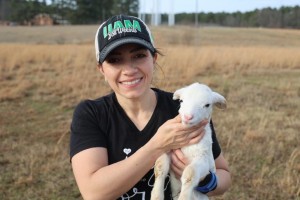Lambing Storm Hits UAM Farm
January 12th, 2023 by
Animal Science Assistant Professor Maribel Nelson has volunteered to monitor this year’s lambing season. So far, the 2nd year herd has delivered a dozen new lambs.
The UAM sheep fields are experiencing what Associate Professor of Animal Science and Veterinarian Dr. Rocky Lindsey calls a “Lambing Storm.” “Seems like whenever one drops they all start dropping day after day. We’ve had two born overnight, that’s been the case. One or two have been born each day for the last week or so, “said Lindsey. He said that the lamb births will continue for another couple of weeks until they are done.
This is the second lambing season for the sheep and goat program at UAM. The hairless sheep were introduced to the College of Forestry, Agriculture and Natural Resources in 2021 as part of expanding the Animal Sciences program. The breed of domestic sheep is called the Katahdin, which is disease resistant. They are known for their meat and do not need shearing.
Lindsey said, “there are a number of first-year ewes having single lambs, which is what you want” He added, “we also have a number of second-year ewes having twins. One of the ewes surprised everyone on New Year’s Eve when she had triplets.
Twins Preferred
Lindsey says twins are preferred. “You get more bang for your buck; the ewes have plenty of milk and the lambs grow well.” He said the triplets can be a problem because the mothers will often reject one or both of the other babies, which was the case of the UAM triplets.
Lindsey said the mama sheep allowed one lamb to nurse and was head-butting and pushing away the other two, so the mother and lambs were caught in placed in a pen to stay together overnight. Lindsey said, “she accepted one of the two abandoned lambs. So as of now she has accepted two of the lambs. The third lamb is being bottle-fed”
Dr. Nelson monitoring lambing operation
Animal Science Assistant Professor and veterinarian Dr. Maribel Nelson has volunteered to monitor this year’s lambing season and has been checking on the sheep herd three times per day and feeding them. It was Nelson who discovered that the mother sheep was rejecting her lambs.
Nelson is making a concentrated effort to interact with the sheep so that she can bond and understand their behaviors. In the long-term Nelson would like UAM to try some new reproductive methods like artificial insemination. Collaborations with other professionals and companies are underway to help move that part of the sheep program forward.
##
About the College of Forestry, Agriculture and Natural Resources and the Arkansas Forest Resources Center
The College of Forestry, Agriculture and Natural Resources, and the Arkansas Forest Resources Center, a University of Arkansas System Center of Excellence, brings together interdisciplinary expertise through a partnership between the University of Arkansas at Monticello and the University of Arkansas System Division of Agriculture. The College and Center are headquartered at the University of Arkansas at Monticello campus, but their programs range statewide with the mission of developing and delivering teaching, research, and extension programs that enhance and ensure the sustainability and productivity of forest-based natural resources and agricultural systems. Academic programs are delivered by the College of Forestry, Agriculture, and Natural Resources through the University of Arkansas at Monticello. Through the University of Arkansas System Division of Agriculture, research is administered by the Arkansas Agricultural Experiment Station, and extension and outreach activities are coordinated by the Arkansas Cooperative Extension Service.
The University of Arkansas at Monticello and the University of Arkansas System Division of Agriculture offer all of their programs to all eligible persons without regard to race, color, sex, gender identity, sexual orientation, national origin, religion, age, disability, marital or veteran status, genetic information, or any other legally protected status, and are Affirmative Action/Equal Opportunity Employers.
About the Division of Agriculture
The University of Arkansas System Division of Agriculture’s mission is to strengthen agriculture, communities, and families by connecting trusted research to the adoption of best practices. Through the Agricultural Experiment Station and the Cooperative Extension Service, the Division of Agriculture conducts research and extension work within the nation’s historic land grant education system.
The Division of Agriculture is one of twenty entities within the University of Arkansas System. It has offices in all seventy-five counties in Arkansas and faculty on five system campuses.
The University of Arkansas System Division of Agriculture offers all its Extension and Research programs and services without regard to race, color, sex, gender identity, sexual orientation, national origin, religion, age, disability, marital or veteran status, genetic information, or any other legally protected status, and is an Affirmative Action/Equal Opportunity Employer.
Choose another article
Newer article: Row Crop Symposium, January 21st @ UAM
Older article: Marianne Robinson Veasey
























































